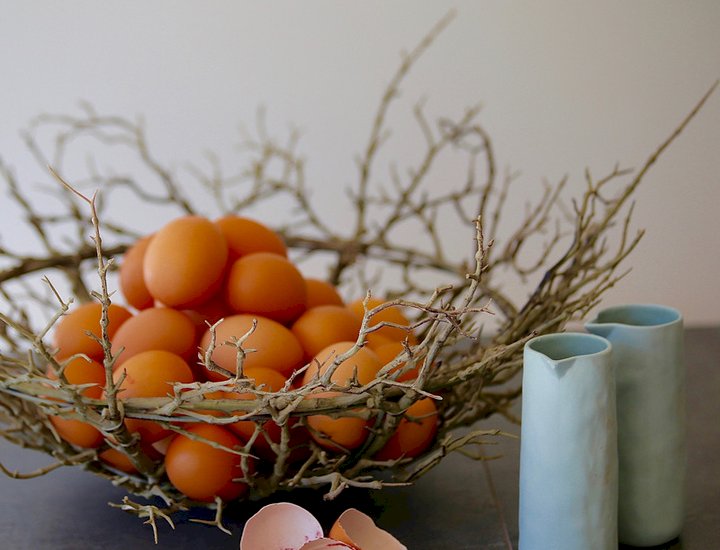Greek Easter Eggs
Most children of Greek heritage would say that their favourite Greek Easter tradition is the ‘egg cracking’ or tsougrisma. After midnight mass on Easter Saturday, everyone returns home to a feast and then a ‘battle’ between dyed Easter eggs begins. Everyone carefully selects an egg and gently (or not so gently) taps the end of their egg against their opponents’ eggs. All opponents continue tapping eggs until a victor is found – an egg and its owner that has cracked all the other eggs and has remained intact! Victory is said to bring good fortune all year long. KO’s Greek Easter eggs are dyed red, the traditional dye colour and feature leaf motifs, also a traditional decoration. Make them for your Easter celebration and join in the fun and good fortune that victory is said to bring!
Ingredients
Ingredients
You will need…
For the Greek Easter
8 eggs at room temperature
6 leaves of different shapes no longer than 3–4cm in length
6 pieces of pantyhose or stockings cut into 12–15cm lengths
6 pieces of thin string cut into 10–12cm lengths
water
2 packets of red egg dye
Extra – 1 cup boiled water
1 cup white vinegar
Scissors
Plastic gloves
1 old tea towel
Cotton wool balls
Olive oil
Preparation
Watch the full recipe video below. Subscribe to my YouTube channel by clicking the Subscribe link on the video.
Make the Easter Eggs
Wash the eggs to remove any dirt or residues. Dry the eggs well with a tea towel.
Place a leaf on an egg, vein side up. Hold the leaf in place and put the egg inside a stocking tube. Adjust the leaf position so that it is centrally placed on the body of the egg and ensure the entire leaf is flat on the egg. Stretch the stocking tightly over the egg. Gather and twist the stocking at the base of the egg. Tightly tie the twisted stocking end with a string. Cut the excess stocking and string.
Repeat for another five eggs.
Arrange all 18 eggs on the base of a large (approximately 3 litre) pot and cover the eggs with water.
Dissolve 2 packets of red egg dye in 1 cup of boiled water. Add the dissolved egg dye mixture to the pot. Gently stir the eggs with a plastic or wooden spoon.
Bring the pot to a gentle boil and boil for 10 minutes. Add 1 cup of vinegar and then continue to boil gently for no more than 5 minutes.
Fit the plastic gloves on your hands. Using a slotted plastic spoon or wooden spoon, remove the eggs from the pot and place on an old tea towel to cool. Remove the stockings and leaves from the decorated eggs. Dry all the eggs with a paper towel. Use cotton wool balls to polish all the eggs with olive oil.
Arrange the eggs in a bowl for serving.
Let the Battle Begin
After midnight mass on Easter Saturday, come home to a feast of mayeritsa (offal stew), tsoureki (Greek Easter egg–loaf) and koulourakia (Greek Easter cookies). Then let the Greek Easter egg battle begin. “Tsougrisma”
Choose your egg and gently (or not so gently) tap the end of your egg against your opponents’ eggs. All opponents continue tapping eggs until a victor is found – an egg and its owner that has cracked all the other eggs and has remained intact!
Victory is said to bring good fortune all year long.







